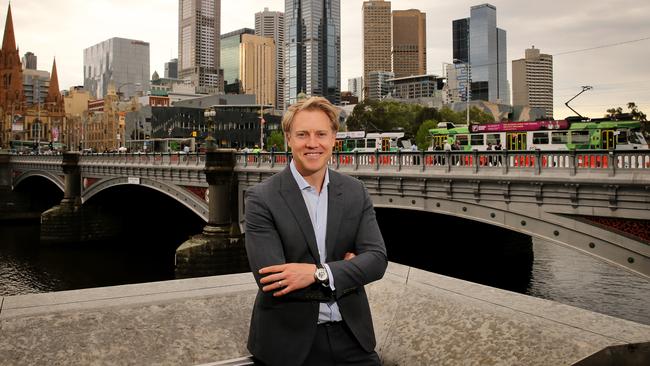Melbourne CBD could be free of cars ‘by 2030’
Melbourne could be transformed into a car-free grid as the CBD struggles with a growing problem of congestion.

Melbourne’s CBD could become free of cars in just over a decade, with the Hoddle grid closed to private vehicles and pedestrians given complete priority, city planning experts say.
Politicians and policymakers told The Australian’s Better Cities forum they could see the city transforming to become a carless grid by 2030, as the CBD struggles with a growing problem of pedestrian congestion.
“I see no cars in the city in Melbourne 2030,” said Cbus Property chief executive Adrian Pozzo. “I see there’s a city shut down to traffic. I see a garden that looks like Central Park in New York, surrounded by high-rise buildings.”
An increase in foot traffic in Melbourne’s centre has been of increasing concern for the local council, with more than 840,000 people passing through the area each day. The figure is likely to rise to more than 1.2 million by 2030.
Deputy mayor Arron Wood told the Better Cities forum the city needed to continue to look at innovative solutions to the problem of pedestrian congestion, or it could lose its internationally recognised livability status.
“I think what we see ... with congestion, I think that’s probably our No 1 threat to livability,” he said.
“You look at people coming out of Southern Cross Station of a morning and people are struggling to fit, literally, onto the footpaths. So what we want to do is use some of that under-utilised road space — and that’s still one of our biggest real-estate areas, is roads — to be more pedestrian-friendly.”
In 2015, former Melbourne City councillor Richard Foster proposed a trial ban on cars and motorbikes in the city for one day, but it was quickly branded “unworkable” by other councillors.
Cities such as Madrid and Oslo are starting to work towards making their central districts accessible only to pedestrians, bikes, buses and taxis within the next two years, while cities like Paris have experimented with car-free days.

Melbourne mayor Robert Doyle told The Australian the Melbourne City Council already had zoned certain areas of the city to be car-free during busy peaks such as lunchtime, and they were open to similar moves in other parts of the city if data showed it would help congestion.
“We have a walking plan, which is planning connectivity, working out which are the preferred walking routes, widening footpaths. We’ve been doing that for 20 years and continue to do it. It’s thinking about right sequencing and enabling people to move safely through the city,” he said.
Ben Rossiter, the head of research and advocacy organisation Victoria Walks, said Melbourne politicians and policy leaders had to start working towards a carless CBD infrastructure now, rather than waiting.
“I definitely think it should be something on the agenda. I’d say leaders in government all recognise that parts of Melbourne CBD are going to become car-free — possibly all of it — but no one is doing the planning for that to occur,” he said. “Walking is important for the city to function economically and socially. We kind of wait for an absolute crisis to occur before we take action.”
Mr Rossiter, the vice-president of the International Federation of Pedestrians, said more should be done to make Melbourne’s “little” streets — such as Little Bourke Street and Little Collins Street — vehicle-free.
“It comes down to who gets priority. We have to prioritise walkers. Particularly if we go forward, it’s not about balance, it’s about the right economic decision.”
He said technology was developing quickly so deliveries to businesses, access for taxis and disability access could all be managed through innovative solutions such as retractable bollards.



To join the conversation, please log in. Don't have an account? Register
Join the conversation, you are commenting as Logout